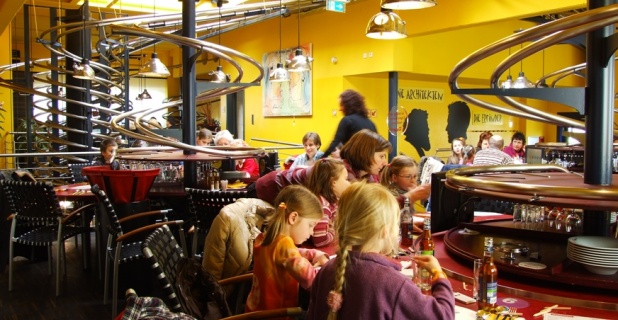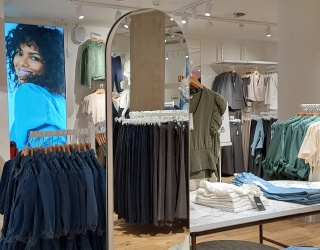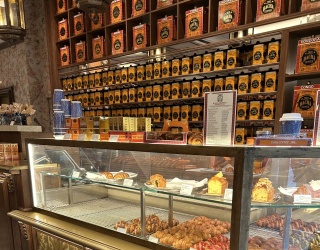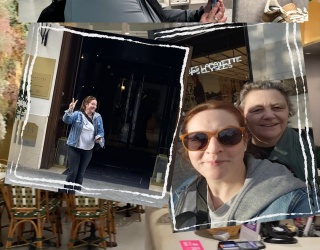
Kuwait, Abu Dhabi and soon Vienna – the rollercoaster restaurants are a unique theme-based gastronomy concept that is spreading widely. Food and beverages are zooming directly to the guest’s table via a rollercoaster. No wonder shopping mall operators are eager to bring this attraction in their venues.
Things run a little differently here than in traditional restaurants: track systems above all of the tables are looping from the ceiling like rollercoasters. Orders placed by visitors on tablets glide to their destination in sealable food containers and bottles where the guests also take them off the tracks on their own.
The containers with the ready-to-serve dishes receive a label from a receipt printer in the kitchen listing the contents along with the destination table so that guests are able to recognize their dishes. The system locates the right table via wireless LAN with chips that are embedded in the fixtures.
The entire system is quite interactive. "This is exactly what makes a visit to our venue so special," explains Richard Jeschke. He is the Managing Director of gastronnovation, the company that designs and builds the restaurants on behalf of the parent company HeineMack GmbH. "My partner Michael Mack, Managing Director of HeineMack, envisioned this interaction when he came up with the idea for this." His experience from the metal industry sector and perhaps the occasional boring visit to cookie-cutter restaurants seem to play a role in this.
What goes up must come down
The track system works almost entirely via gravitational force. "Only the speed at the loopings is electronically controlled so that dishes are neither moving too fast nor too slow," says Jeschke. "If the kitchen is located at the same level as the dining room, the dishes are also first transported up to a collecting platform through a steep incline conveyor system we developed ourselves," he adds.
It took two years to develop the system before it was ready for the market – the first restaurant opened in Nuremberg in 2007. "After all, the dishes shouldn’t look as if they have been put through the wringer when they arrive at the guest’s table. The bottles also needed to be opened without foaming over," he adds. Many technical prerequisites had to be resolved and some technicians needed some convincing as well. There was no getting around a little bit of physics. "We find support for such innovations with architects and scientists," Jeschke points out.
International success
From its inception until today, the concept seems to be very successful. At this point, there are spin-offs in Dresden, Hamburg, the Europa-Park in Rust, Kuwait, Abu Dhabi and Sochi and soon in Vienna. They are largely operated based on licensing models. Jeschke explains, "We collaborate with on-site partners for the international projects. We are still a relatively small company and would not be able to operate a franchise on an international level by ourselves at this point."
The Managing Director says that it’s hard to say which location is the most successful. "Viewed individually, every single one of them is very successful. Visitors sometimes travel a long way to see the restaurants for themselves."
Given all of this action, do guests actually pay attention to the quality of the dishes? "In Nuremberg – which is the location we manage ourselves – we emphasize organic products that are on par with comparable restaurants in terms of price. The menu choices attract many regulars to the locations in the city centers," says Jeschke and is nevertheless convinced that “The experience is ultimately the most important aspect."
This is perhaps also the reason why presently numerous shopping centers inquire at HeineMack GmbH on how to situate a rollercoaster restaurant in their venues. "This type of interactive entertainment is perfectly suited during times when customers stay away from shopping malls and the creation of experiences is increasingly being emphasized," says Jeschke. "However, this frequently falls short due to spatial requirements."
The rollercoasters require a minimum height of nine to eleven meters. "The shopping center in Abu Dhabi has made major concessions in this regard for all of this to work," he emphasizes. Yet the effort has paid off, he says. Based on the numbers, the restaurant is a genuine attraction of the mall.
Before the restaurants were opened in the Arab countries, the company was initially worried whether the interactive concept would pay off – after all, the focus there is said to be more on great service. "What’s more, single men must not be seated next to single women at the same table. We didn’t know whether the software would be able to handle this. However, all of our worries were unfounded –people love it," says Jeschke and he is satisfied.
Special training for the staff
The active guests don’t eliminate staff for the operator. After all, the tables need to be cleared off and the facility needs to be serviced. "What’s more, all guests are accompanied to their tables and instructed on how the system works. Older people sometimes have a harder time with this. However, the tablet alone is a big highlight for children. Aside from the digital menu, it also features games and information," adds Jeschke.
The staff is thoroughly trained before the restaurant opening to master the specific restaurant processes as perfectly as possible. Either on-site at the restaurant or in the training restaurant in Nuremberg. Chefs also need to discard their old notions of traditional kitchens. The kitchens here are actually built entirely differently than cooks are used to since all processes are geared towards the track system.
Future prospects
The restaurant in Vienna is scheduled to open this summer. However, there are still a few technical challenges to overcome. Yet Richard Jeschke is optimistic, "This is going to be our master franchise. We are going to offer this model within Europe."
Autor: Natascha Mörs, iXtenso.com




